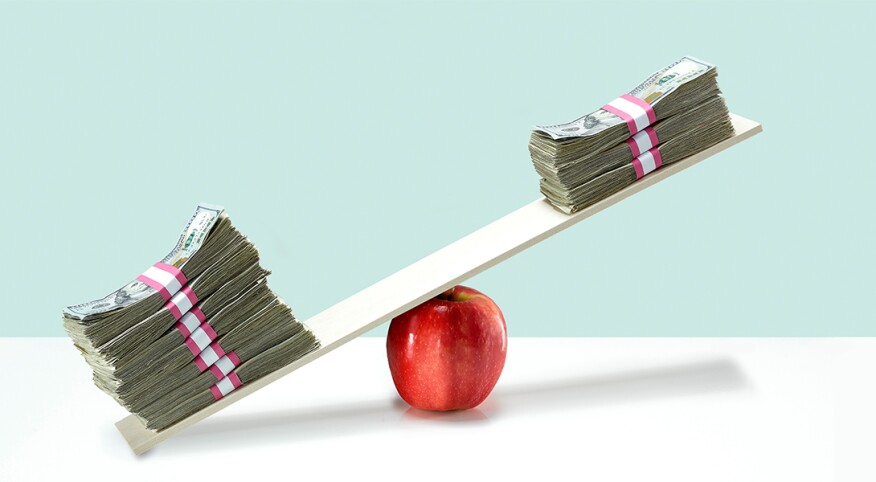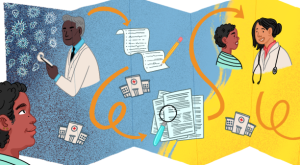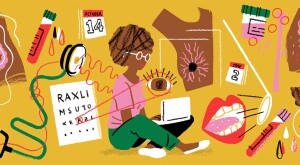First, the good news. Sisters are chasing that paper like nobody else. Compared to other ethnic groups, we hold the largest proportion of degrees relative to men of the same background. Over 50 thousand black students enrolled in grad schools for the first time last year—and two thirds of them were sisters. Black scholars are well-represented in fields like public administration and education.
This pursuit of higher education comes with a price, however. Next to mortgages, student loans now make up the second largest portion of personal debt in America. Attorney and entrepreneur Nadia Policard, 42, is a single mom of three teens. Not only does she face the prospect of paying for their college, but she also had to put her own student debt payments on hold following the end of her 16-year marriage and a corporate layoff. Struggling to fill the wide gaps that her limited child support didn’t, she amassed $45,000 in credit card bills in addition to her $83,000 loan balance. Weeks after her job loss two years ago, she had to borrow $60 from her oldest son to help pay the rent.
If, like many sisters on their grind, you are in constant panic because there’s never enough money from check to check to pay off education loans and fund your retirement, we get it. But, “when you’re 30 or 35, it’s too easy to say to yourself ‘I'll catch up later’ and then the next thing you know, you’re 50 or 55 with little to no savings,” says Lynette Khalfani-Cox, founder of AskTheMoneyCoach.com.
Some researchers term this too-familiar struggle “the middle-class squeeze.” Wages are stagnant, but the cost of housing, health care, tuition and more continues to skyrocket. For example, the cost of college soared nearly eight times faster than wages did between 1989 and 2016. Translation: From the time Gen Xers graduated college through the time we started writing checks for tuition for our kids, the selling price of a sheepskin has snowballed.
It’s no wonder student loan debt among adults age 50 and older accounted for $289.5 billion in 2018, up from $47.3 billion in 2004. Nearly 85 percent of Black bachelor’s degree recipients carry student debt, compared with 69 percent of white recipients, according to one report. The amounts we owe tend to be greater and we default at higher rates. The structural discrimination that impedes our ability to build generational wealth is a key reason, say experts. “This longstanding racial wealth gap accounts for the inability of most African American families to fund education without assistance,” explains personal finance educator Faneisha Alexander. She adds that the inability to pay these loans back can also be driven by the fact that women of color are often financially responsible for aging parents.
What’s a sister to do? Here’s what not to do, no matter what: Ignore the problem and default. The last thing you want is the feds garnishing your Social Security in your golden years. The first thing to do is realize that it’s not your fault and that you’re not alone. The second is to investigate and weigh your options.
With careful planning and belt-tightening, most of us can afford to shrink diploma debt and fatten our 401(k) plans. But you’ve got to be positive, proactive and purposeful about it, just like Nadia Policard is doing. With the five-figure credit debt paid off (thanks to taking a part-time job as a contract attorney and using some of her divorce settlement), she’s got a plan to erase her massive student loan debt over the next four years. “No matter how dismal your financial situation may seem, keep going and stay faithful,” she says. “Know exactly how much money you need to get to where you want be financially, work the numbers backwards from that point, then get to work.”
She can get there. So can you. “Sisters from AARP” turned to top money pros for their best advice:
Ask about repayment perks at work. A growing number of employers provide student loan repayment assistance. In fact, Forbes called this "the hottest benefit of 2018." Ask your HR department if a program is available at your workplace, says Khalfani-Cox.
Seek out student loan forgiveness. If you’re in a helping profession, you may be eligible. “These are people I call the ‘do-gooders of the world’ including teachers, social workers, cops, firefighters, doctors and nurses, especially those who work in areas of the country where there’s a critical shortage of health care workers,” says Khalfani-Cox. If you are totally and permanently disabled, you may qualify for a complete discharge of your federal student loans. If so you may be required to submit documentation of your income after you’re off the hook. Learn more at the U.S. Department of Education.
Know where every dollar is going. AARP’s budget calculator is a great place to start. An app like Mint or You Need a Budget can also help. “A budget provides visibility,” says Alexander, who managed to pay off her own $78,000 student debt within three years. “Without it, your finances become a guessing game.”
Make this your mantra: “I don’t need to buy that.” One of Alexander’s clients found hundreds in her monthly budget by not buying wine every week and eating out less. Here are 99 Great Ways to Save.
Don’t miss payments! Pay at least the minimum due on every loan. For resources that describe how to renegotiate with your lender, search “repay student debt” at consumerfinance.gov.
Be intense and intentional. On his radio show, financial guru Dave Ramsey repeats advice like sell everything not nailed down and live on beans and rice. For Policard, that meant no more nail or hair appointments, less eating out, and no borrowing. She adds, “I was also transparent with my kids; things were different and money was tight.” Wearing her hair natural, meal planning and cutting cable and satellite radio helped, too. However, Alexander cautions against eliminating self-care from your spending plan.
Get your gig on. Alexander advises picking up side jobs to pay down debt faster. To get started, check out these side hustle ideas. Policard, now self-employed as CEO of both The Network Niche Influencer Agency and Social Channel Marketing Group, ramped up these sideline businesses while still working as a contract attorney.
Take advantage of a 401(k) match. Employers often match 50 cents on the dollar for every retirement dollar you contribute up to, typically, 5 or 6 percent of your salary. Don’t leave this free money on the table. But do consider capping your contributions at that level to free up income for debt reduction, says Alexander.
Think carefully before placing your 401(k) contributions on pause. Opting to stop payroll deductions depends on your situation, says Alexander. Consulting with a financial planner is smart. “I personally took this approach. But my employer still made contributions to my [pension]. I would only recommend this to those who can pay off their balance in fewer than five years. Any longer period inhibits your ability to leverage time when investing.”
Consider contributing to a traditional IRA where you can save up to $6,000 per year and get an up-front tax deduction. If you’re 50 or older, you can add an extra $1,000 catch-up contribution. Or, contribute to a Roth IRA. You’ll make contributions with after-tax dollars, but you’ll enjoy tax-free withdrawals on qualified distributions in the future.
Funnel any financial windfall toward diploma debt. If there’s a gift, bonus or inheritance in your future, you could apply a lump sum to your debt and send the balance to your retirement savings.
Don’t raid your emergency fund for loan repayment. If you do, when that rainy day comes, you’re likelier to borrow at high interest rates to deal with it. Ultimately, experts recommend having a minimum of three months’ worth of expenses saved for emergencies. However, when working to save and pay off debt, that can be difficult. Therefore, “having a minimum of $1,000 saved until your debt is paid should be enough to cover any minor emergencies,” says Alexander.
Proud of her aggressive measures to pay down debt, Policard recalls, “things were different and money was tight, but I had it under control. I am still self-employed and happy with where I am financially. I pay my credit card balances in full every month.” With the squeeze eased, she’s now able to funnel savings into an annuity retirement account she opened with the 401(k) rollover from her previous job.
Her new proactive mindset has brought peace of mind. Policard says she regrets that during her marriage, she left major money decisions to her former husband. Back then, she says “I didn't even know how much I had in my retirement accounts. When I took charge of my finances, I took control of my life and my anxiety around money.”

Gregory Reid










